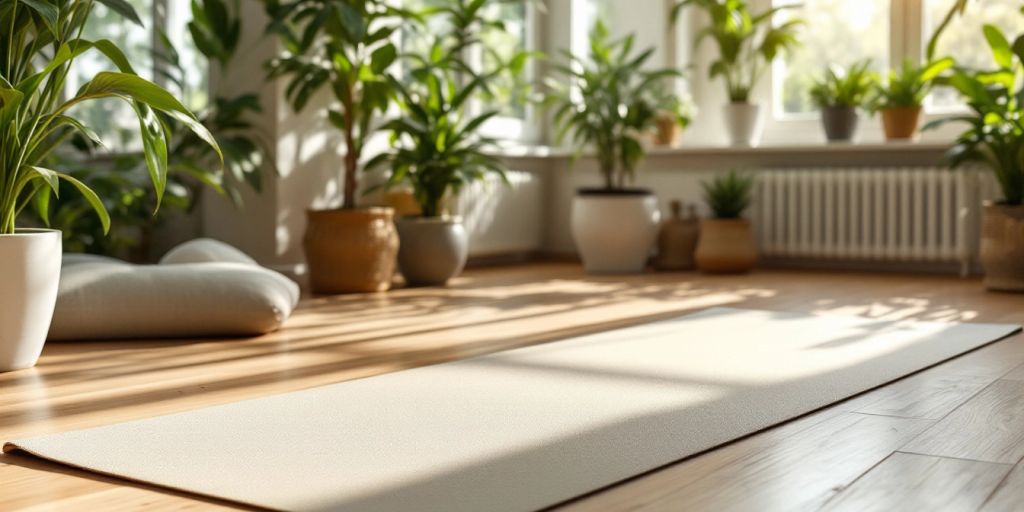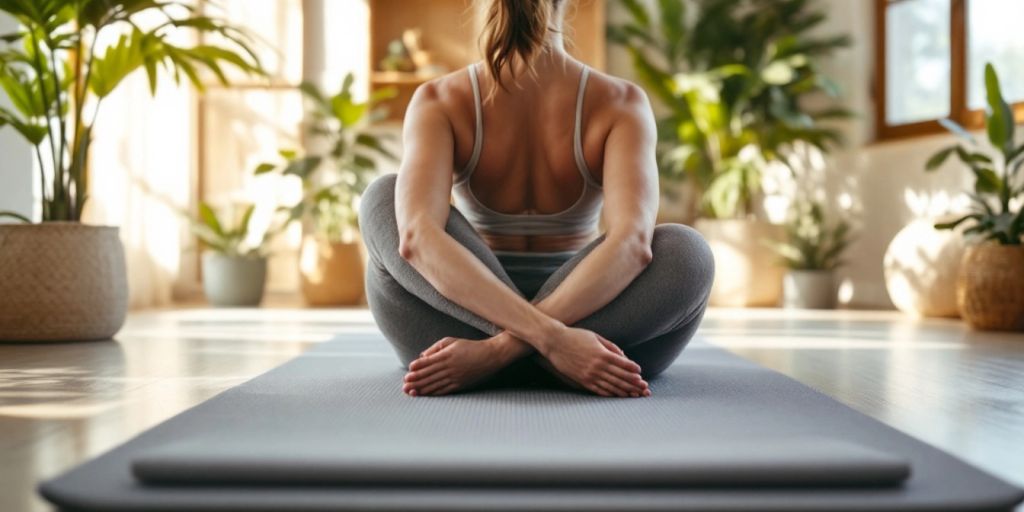
Discover the Best Non Toxic Yoga Mat for Your Eco-Friendly Practice
Yoga is more than just a workout; it's a way to connect your mind and body while being mindful of the environment. Selecting a non-toxic yoga mat is a key part of creating a safe and eco-friendly practice. In this article, we will uncover the best non-toxic yoga mats available, focusing on what makes them special and beneficial for both your health and the planet.
Key Takeaways
- Non-toxic yoga mats are better for your health and the environment.
- Materials like natural rubber, cork, and organic cotton are safe and sustainable.
- Look for mats that offer good grip and last a long time.
- Popular brands include Manduka and Jade Yoga, known for their eco-friendly choices.
- Taking care of your mat can help it last longer and perform better.
Understanding Non-Toxic Yoga Mats
Choosing a non-toxic yoga mat is crucial for a safe and eco-friendly practice. These mats are made from natural materials that are better for your health and the environment. Here’s why they matter:
Importance of Choosing Non-Toxic Mats
- Healthier for You: Non-toxic mats reduce your exposure to harmful chemicals found in traditional mats.
- Eco-Friendly: They are made from sustainable materials, helping to protect our planet.
- Comfortable: Natural materials provide better cushioning and support during your practice.
Health Benefits of Non-Toxic Materials
- Reduced Chemical Exposure: Non-toxic mats minimize harmful substances.
- Hypoallergenic: They are less likely to cause allergic reactions.
- Skin-Friendly: Free from harsh chemicals that can irritate your skin.
Environmental Impact of Traditional Mats
Traditional yoga mats often contain harmful materials like PVC, which can harm the environment. Here’s a quick comparison:
| Material Type | Environmental Impact | Health Risks |
|---|---|---|
| PVC | High | Endocrine disruptors |
| Natural Rubber | Low | Minimal |
| TPE | Moderate | Some concerns |
Choosing a non-toxic yoga mat not only benefits your health but also supports a healthier planet. Opt for materials that are sustainable and free from harmful chemicals to enhance your yoga practice while being kind to the environment.
In summary, selecting a non-toxic yoga mat is an important step towards a healthier practice and a cleaner planet. Look for mats made from natural materials like rubber, cork, and organic cotton to ensure a safe and eco-friendly experience.
Also, consider options like the Yune Flint Yoga Mat, which is designed for comfort and durability while being free of harmful substances like phthalate and latex.
By making informed choices, you can enjoy your yoga sessions while caring for your health and the Earth.
Top Materials for the Best Non-Toxic Yoga Mat

When selecting a yoga mat, the materials used are crucial for both your health and the environment. Here are some of the best non-toxic materials to consider:
Natural Rubber: A Sustainable Choice
Natural rubber is a top pick for yoga mats because of its great grip and durability. It comes from the sap of rubber trees, making it a renewable resource. Here are some key points about natural rubber mats:
- Eco-Friendly: Sourced from sustainable rubber trees.
- Non-Toxic: Free from harmful chemicals found in synthetic mats.
- Comfortable: Provides good cushioning for your joints.
Cork: Eco-Friendly and Durable
Cork is another excellent option for yoga mats. It is harvested from the bark of cork oak trees, which can regenerate, making it a sustainable choice. Here’s what you should know about cork mats:
- Natural Antimicrobial Properties: Helps resist mold and bacteria.
- Non-Slip Surface: Stays grippy even when wet, perfect for hot yoga.
- Lightweight: Easy to carry to and from your yoga sessions.
Organic Cotton and Wool Options
Organic cotton and wool are also great materials for yoga mats. They are soft, breathable, and free from harmful chemicals. Here are some benefits:
- Soft and Comfortable: Gentle on the skin, ideal for restorative practices.
- Biodegradable: These materials break down naturally, reducing waste.
- Hypoallergenic: Less likely to cause allergic reactions.
Choosing a non-toxic yoga mat not only supports your health but also contributes to a greener planet. By making this choice, you are taking a step towards a more sustainable lifestyle.
In summary, when looking for a non-toxic yoga mat, consider options made from natural rubber, cork, or organic cotton. These materials are not only better for your health but also for the environment. Brentwood Home offers a great cotton yoga mat that is GOTS-certified, ensuring it meets high standards for organic materials.
Features to Look for in a Non-Toxic Yoga Mat

When selecting a non-toxic yoga mat, there are several key features to keep in mind to ensure a safe and enjoyable practice. Here are the main aspects to consider:
Grip and Stability
- Non-slip surface: Look for mats with a textured surface to prevent slipping during poses.
- Material choice: Natural rubber and cork are excellent for grip.
- Thickness: A thicker mat can provide more cushioning and stability.
Durability and Longevity
- Material quality: Choose mats made from high-quality, sustainable materials like natural rubber or cork.
- Resistance to wear: Check for mats that resist tearing and wear over time.
- Maintenance: Some materials are easier to clean and maintain than others.
Portability and Weight
- Lightweight: Easy to carry to and from your yoga sessions.
- Compact design: Mats that roll up easily are more convenient for travel.
- Carrying options: Look for mats that come with straps or bags for easy transport.
Choosing a non-toxic yoga mat is essential for a healthier practice. It not only benefits your body but also helps the environment.
In summary, when selecting a yoga mat, consider materials like natural rubber, cork, and organic cotton or wool. Each offers unique benefits that contribute to a safer and more eco-friendly practice. Always look for mats that prioritize sustainability and non-toxicity to ensure a greener yoga experience.
Popular Non-Toxic Yoga Mat Brands
When it comes to choosing a non-toxic yoga mat, several brands stand out for their commitment to eco-friendly materials and practices. Here are some of the most popular options:
Manduka: Leading the Way in Eco-Friendly Mats
Manduka is known for its high-quality yoga mats made from natural rubber. Their mats are designed to last, providing excellent grip and support for all types of yoga practices. They also focus on sustainable production methods, making them a favorite among eco-conscious yogis.
Jade Yoga: Combining Comfort and Sustainability
Jade Yoga mats are made from natural rubber and are free from harmful chemicals. They offer a great balance of comfort and durability, making them suitable for both beginners and experienced practitioners. Additionally, for every mat sold, Jade Yoga plants a tree, contributing to environmental restoration.
Brentwood Home: American-Made and Biodegradable
Brentwood Home produces yoga mats using GOTS-certified organic cotton and natural Dunlop latex. Their mats are biodegradable and made in the USA, ensuring a lower carbon footprint. They are perfect for those who want a soft, comfortable surface for their practice.
| Brand | Material Used | Key Features |
|---|---|---|
| Manduka | Natural Rubber | Durable, excellent grip |
| Jade Yoga | Natural Rubber | Eco-friendly, tree planting initiative |
| Brentwood Home | Organic Cotton, Natural Latex | Biodegradable, made in the USA |
Choosing a non-toxic yoga mat not only benefits your health but also supports a healthier planet. Opt for materials that are sustainable and free from harmful chemicals to enhance your yoga practice while being kind to the environment.
These brands are leading the charge in providing safe, eco-friendly options for yoga enthusiasts. By selecting a mat from one of these companies, you can feel good about your choice for both your health and the planet.
Caring for Your Non-Toxic Yoga Mat
Taking care of your non-toxic yoga mat is crucial for keeping it in good shape and ensuring it lasts a long time. Here are some helpful tips:
Cleaning Tips for Longevity
- Natural Rubber: Wipe it down with a damp cloth and mild soap. Avoid soaking it in water.
- Cork: Use a soft cloth with a gentle cleaner to keep its surface nice.
- Cotton/Wool: You can machine wash it on a gentle cycle, but make sure to air dry it to prevent shrinking.
Storage Solutions to Maintain Quality
- Roll it Up: Always roll your mat instead of folding it to avoid creases.
- Keep it Dry: Store it in a cool, dry place away from direct sunlight.
- Use a Mat Bag: A bag can protect it from dust and damage.
When to Replace Your Yoga Mat
- If you see significant wear and tear.
- If it starts to smell bad even after cleaning.
- If it no longer provides enough grip.
Regular maintenance is key to ensuring your mat remains safe and effective for your practice. By following these simple steps, you can enjoy a cleaner, safer, and longer-lasting yoga mat that supports your eco-friendly lifestyle!
The Future of Eco-Friendly Yoga Practices
As we move forward, the yoga community is shifting towards more sustainable practices. The future of yoga is not just about mastering poses; it’s also about making choices that benefit our health and the planet. Here are some important areas to think about:
Innovations in Yoga Mat Materials
- Biodegradable options: New materials are being created that break down naturally, which helps reduce waste.
- Recycled materials: Many brands are now using recycled plastics and other materials to make mats.
- Natural fibers: Mats made from jute, hemp, and other natural fibers are becoming popular for their eco-friendliness.
The Role of Consumers in Driving Change
- Demand for transparency: More consumers are asking brands about how they source and make their products.
- Support for sustainable brands: Choosing to buy from companies that focus on sustainability can change market trends.
- Community engagement: Joining local eco-friendly yoga groups can help spread awareness and encourage others to make greener choices.
Benefits of a Greener Yoga Practice
- Healthier environment: Using non-toxic mats helps create cleaner air and reduces pollution.
- Personal well-being: Practicing on eco-friendly mats can strengthen your connection to nature and boost your mental health.
- Community impact: Supporting sustainable practices helps build a community focused on health and environmental responsibility.
The future of yoga is bright, with a strong focus on personalization, accessibility, and connection. By choosing eco-friendly options, we can all contribute to a healthier planet while enjoying our practice.
In summary, as we embrace these changes, we can look forward to a yoga practice that is not only beneficial for ourselves but also for the Earth. Choosing a non-toxic yoga mat is a vital step towards a healthier yoga experience and a cleaner planet.
Final Thoughts on Choosing a Non-Toxic Yoga Mat
In conclusion, selecting a non-toxic yoga mat is a vital step towards a healthier yoga routine and a cleaner environment. The mats we've discussed offer various options, materials, and price ranges, ensuring there's something for everyone. By choosing one of these eco-friendly mats, you not only enhance your yoga experience but also help reduce your impact on the planet. Remember, every small choice counts when it comes to building a greener future. Enjoy your yoga journey with a mat that cares for both your practice and the Earth.
Frequently Asked Questions
What materials are used to make non-toxic yoga mats?
Non-toxic yoga mats are made from safe materials like natural rubber, cork, cotton, and wool. These materials do not release harmful chemicals.
Why is it important to choose a non-toxic yoga mat?
Choosing a non-toxic yoga mat is better for your health and the environment. They don't have harmful substances that can affect your body or the planet.
How should I clean my non-toxic yoga mat?
You can clean your non-toxic yoga mat using a mix of water and mild soap. Just wipe it down with a cloth and let it air dry.
Are non-toxic yoga mats more expensive than regular ones?
Non-toxic yoga mats can be a bit pricier than regular mats, but they are worth it for their safety and durability.
How long can I expect my non-toxic yoga mat to last?
With proper care, non-toxic yoga mats can last several years. Their lifespan depends on how often you use and clean them.
Can I use a non-toxic yoga mat for hot yoga?
Yes, many non-toxic yoga mats are designed to handle sweat and provide good grip, making them suitable for hot yoga.


